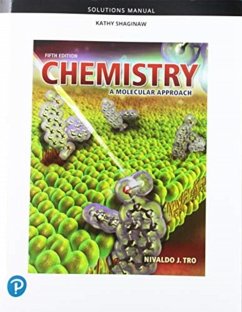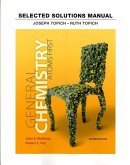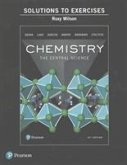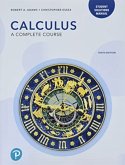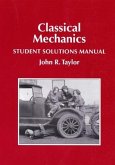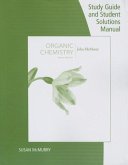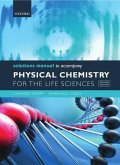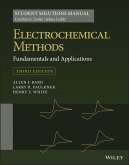- Broschiertes Buch
- Merkliste
- Auf die Merkliste
- Bewerten Bewerten
- Teilen
- Produkt teilen
- Produkterinnerung
- Produkterinnerung
This solution manual contains step-by-step solutions to all complete, end-of-chapter exercises. With instructor permission, this manual may be made available to students.
Andere Kunden interessierten sich auch für
![Student Solutions Manual for General Chemistry Student Solutions Manual for General Chemistry]() John McMurryStudent Solutions Manual for General Chemistry140,99 €
John McMurryStudent Solutions Manual for General Chemistry140,99 €![Instructor's Solutions Manual for Exercises for Chemistry Instructor's Solutions Manual for Exercises for Chemistry]() Theodore BrownInstructor's Solutions Manual for Exercises for Chemistry31,99 €
Theodore BrownInstructor's Solutions Manual for Exercises for Chemistry31,99 €![Student Solutions Manual for Calculus Student Solutions Manual for Calculus]() Robert AdamsStudent Solutions Manual for Calculus27,99 €
Robert AdamsStudent Solutions Manual for Calculus27,99 €![Classical Mechanics Student Solutions Manual Classical Mechanics Student Solutions Manual]() John R TaylorClassical Mechanics Student Solutions Manual55,99 €
John R TaylorClassical Mechanics Student Solutions Manual55,99 €![Study Guide with Student Solutions Manual for McMurry's Organic Chemistry, 9th Study Guide with Student Solutions Manual for McMurry's Organic Chemistry, 9th]() John E. McMurryStudy Guide with Student Solutions Manual for McMurry's Organic Chemistry, 9th300,99 €
John E. McMurryStudy Guide with Student Solutions Manual for McMurry's Organic Chemistry, 9th300,99 €![Solutions Manual to accompany Physical Chemistry for the Life Sciences Solutions Manual to accompany Physical Chemistry for the Life Sciences]() Charles Trapp (USA University of Louisville)Solutions Manual to accompany Physical Chemistry for the Life Sciences71,99 €
Charles Trapp (USA University of Louisville)Solutions Manual to accompany Physical Chemistry for the Life Sciences71,99 €![Electrochemical Methods: Fundamentals and Applications, 3e Student Solutions Manual Electrochemical Methods: Fundamentals and Applications, 3e Student Solutions Manual]() Cynthia G. Zoski (The University of Texas at Austin, Austin, TX, USElectrochemical Methods: Fundamentals and Applications, 3e Student Solutions Manual69,99 €
Cynthia G. Zoski (The University of Texas at Austin, Austin, TX, USElectrochemical Methods: Fundamentals and Applications, 3e Student Solutions Manual69,99 €-
-
-
This solution manual contains step-by-step solutions to all complete, end-of-chapter exercises. With instructor permission, this manual may be made available to students.
Hinweis: Dieser Artikel kann nur an eine deutsche Lieferadresse ausgeliefert werden.
Hinweis: Dieser Artikel kann nur an eine deutsche Lieferadresse ausgeliefert werden.
Produktdetails
- Produktdetails
- Verlag: Pearson Education (US)
- 5 ed
- Seitenzahl: 1008
- Erscheinungstermin: 25. Januar 2019
- Englisch
- Abmessung: 216mm x 277mm x 56mm
- Gewicht: 2420g
- ISBN-13: 9780134989815
- ISBN-10: 0134989813
- Artikelnr.: 57034235
- Herstellerkennzeichnung
- Libri GmbH
- Europaallee 1
- 36244 Bad Hersfeld
- gpsr@libri.de
- Verlag: Pearson Education (US)
- 5 ed
- Seitenzahl: 1008
- Erscheinungstermin: 25. Januar 2019
- Englisch
- Abmessung: 216mm x 277mm x 56mm
- Gewicht: 2420g
- ISBN-13: 9780134989815
- ISBN-10: 0134989813
- Artikelnr.: 57034235
- Herstellerkennzeichnung
- Libri GmbH
- Europaallee 1
- 36244 Bad Hersfeld
- gpsr@libri.de
About our author Nivaldo Tro has been teaching college Chemistry since 1990 and is currently teaching at Santa Barbara Community College. He received his Ph.D. in chemistry from Stanford University for work on developing and using optical techniques to study the adsorption and desorption of molecules to and from surfaces in ultrahigh vacuum. He then went on to the University of California at Berkeley, where he did postdoctoral research on ultrafast reaction dynamics in solution. Professor Tro has been awarded grants from the American Chemical Society Petroleum Research Fund, the Research Corporation, and the National Science Foundation to study the dynamics of various processes occurring in thin adlayer films adsorbed on dielectric surfaces. Professor Tro lives in Santa Barbara with his wife, Ann, and their four children, Michael, Ali, Kyle, and Kaden. In his leisure time, Professor Tro enjoys mountain biking, surfing, and being outdoors with his family.
Brief Contents
1. Matter, Measurement, and Problem Solving
2. Atoms and Elements
3. Molecules and Compounds
4. Chemical Reactions and Chemical Quantities
5. Introduction to Solutions and Aqueous Reactions
6. Gases
7. Thermochemistry
8. The Quantum-Mechanical Model of the Atom
9. Periodic Properties of the Elements
10. Chemical Bonding I: The Lewis Model
11. Chemical Bonding II: Molecular Shapes, Valence Bond Theory, and
Molecular Orbital Theory
12. Liquids, Solids, and Intermolecular Forces
13. Solids and Modern Materials
14. Solutions
15. Chemical Kinetics
16. Chemical Equilibrium
17. Acids and Bases
18. Aqueous Ionic Equilibrium
19. Free Energy and Thermodynamics
20. Electrochemistry
21. Radioactivity and Nuclear Chemistry
22. Organic Chemistry
23. Biochemistry
24. Chemistry of the Nonmetals
25. Metals and Metallurgy
26. Transition Metals and Coordination Compounds
Appendix I Common Mathematical Operations in Chemistry Appendix II Useful
Data Appendix III Answers to Selected Exercises Appendix IV Answers to
In-Chapter Practice Problems
1. Matter, Measurement, and Problem Solving
2. Atoms and Elements
3. Molecules and Compounds
4. Chemical Reactions and Chemical Quantities
5. Introduction to Solutions and Aqueous Reactions
6. Gases
7. Thermochemistry
8. The Quantum-Mechanical Model of the Atom
9. Periodic Properties of the Elements
10. Chemical Bonding I: The Lewis Model
11. Chemical Bonding II: Molecular Shapes, Valence Bond Theory, and
Molecular Orbital Theory
12. Liquids, Solids, and Intermolecular Forces
13. Solids and Modern Materials
14. Solutions
15. Chemical Kinetics
16. Chemical Equilibrium
17. Acids and Bases
18. Aqueous Ionic Equilibrium
19. Free Energy and Thermodynamics
20. Electrochemistry
21. Radioactivity and Nuclear Chemistry
22. Organic Chemistry
23. Biochemistry
24. Chemistry of the Nonmetals
25. Metals and Metallurgy
26. Transition Metals and Coordination Compounds
Appendix I Common Mathematical Operations in Chemistry Appendix II Useful
Data Appendix III Answers to Selected Exercises Appendix IV Answers to
In-Chapter Practice Problems
Brief Contents
1. Matter, Measurement, and Problem Solving
2. Atoms and Elements
3. Molecules and Compounds
4. Chemical Reactions and Chemical Quantities
5. Introduction to Solutions and Aqueous Reactions
6. Gases
7. Thermochemistry
8. The Quantum-Mechanical Model of the Atom
9. Periodic Properties of the Elements
10. Chemical Bonding I: The Lewis Model
11. Chemical Bonding II: Molecular Shapes, Valence Bond Theory, and
Molecular Orbital Theory
12. Liquids, Solids, and Intermolecular Forces
13. Solids and Modern Materials
14. Solutions
15. Chemical Kinetics
16. Chemical Equilibrium
17. Acids and Bases
18. Aqueous Ionic Equilibrium
19. Free Energy and Thermodynamics
20. Electrochemistry
21. Radioactivity and Nuclear Chemistry
22. Organic Chemistry
23. Biochemistry
24. Chemistry of the Nonmetals
25. Metals and Metallurgy
26. Transition Metals and Coordination Compounds
Appendix I Common Mathematical Operations in Chemistry Appendix II Useful
Data Appendix III Answers to Selected Exercises Appendix IV Answers to
In-Chapter Practice Problems
1. Matter, Measurement, and Problem Solving
2. Atoms and Elements
3. Molecules and Compounds
4. Chemical Reactions and Chemical Quantities
5. Introduction to Solutions and Aqueous Reactions
6. Gases
7. Thermochemistry
8. The Quantum-Mechanical Model of the Atom
9. Periodic Properties of the Elements
10. Chemical Bonding I: The Lewis Model
11. Chemical Bonding II: Molecular Shapes, Valence Bond Theory, and
Molecular Orbital Theory
12. Liquids, Solids, and Intermolecular Forces
13. Solids and Modern Materials
14. Solutions
15. Chemical Kinetics
16. Chemical Equilibrium
17. Acids and Bases
18. Aqueous Ionic Equilibrium
19. Free Energy and Thermodynamics
20. Electrochemistry
21. Radioactivity and Nuclear Chemistry
22. Organic Chemistry
23. Biochemistry
24. Chemistry of the Nonmetals
25. Metals and Metallurgy
26. Transition Metals and Coordination Compounds
Appendix I Common Mathematical Operations in Chemistry Appendix II Useful
Data Appendix III Answers to Selected Exercises Appendix IV Answers to
In-Chapter Practice Problems

